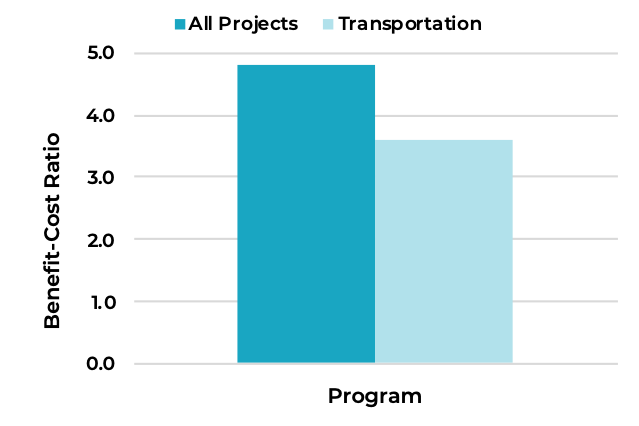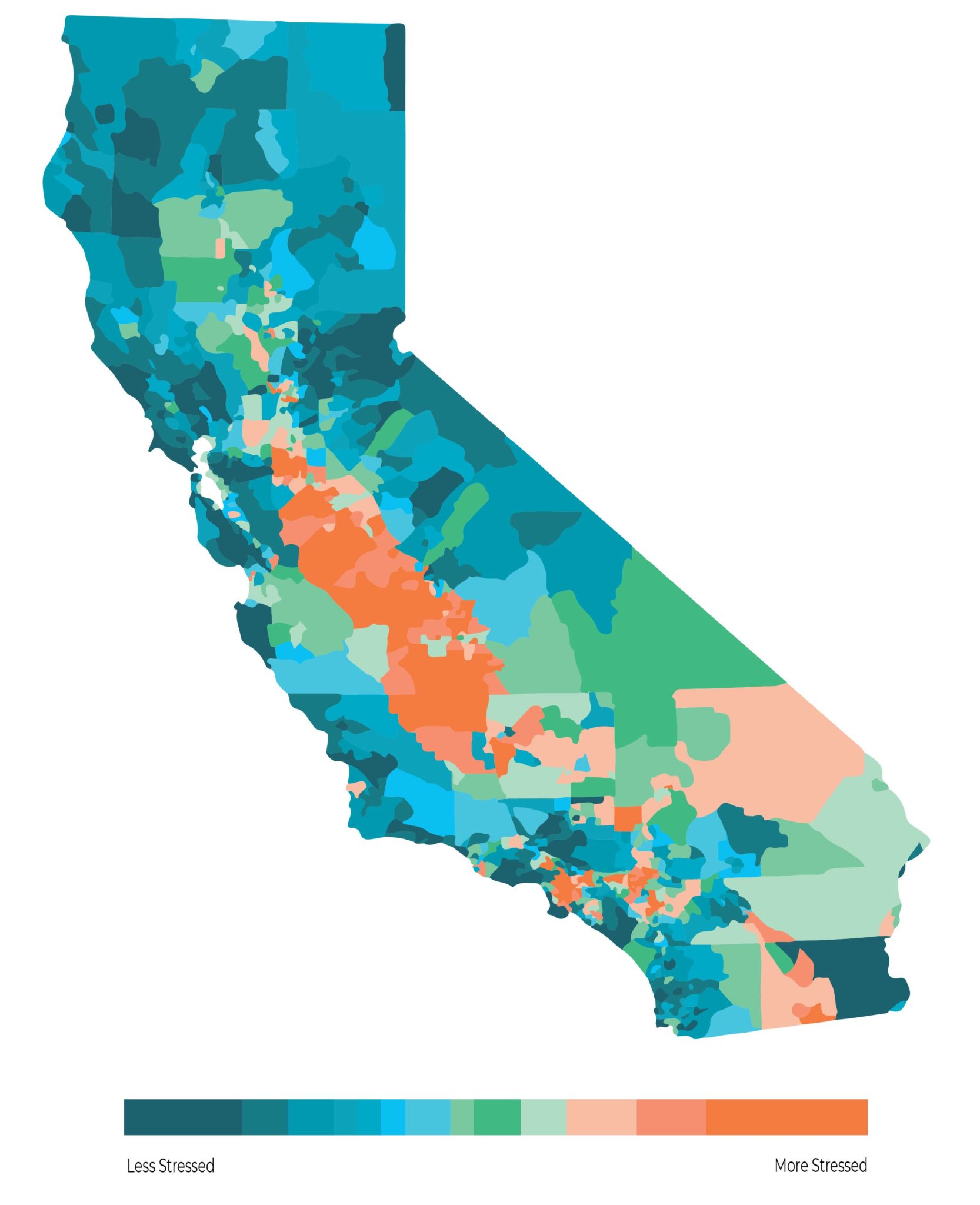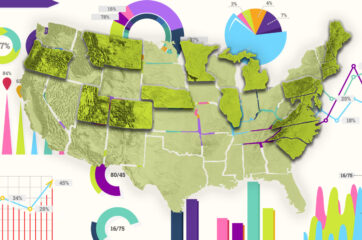We compare the costs of greenhouse gas reduction programs to the value of reducing the worldwide dangers of climate change and of improving health outcomes to determine whether the programs are a cost-effective means for spending large amounts of state resident’s and employer’s funds. Our findings are a useful guide to other states and regions contemplating the use of carbon pricing to create a price incentive to reduce emissions and to generate funds for programs to cut GHG emissions and to provide co-benefits.
California has an economy-wide cap-and-trade system for greenhouse gases (GHG) that began in 2012 and now covers electricity, transportation, industry, and heating. About 45 percent of the revenues from cap-and trade are invested in programs to further reduce greenhouse gases across economic sectors through the California Climate Investments (CCI).
In California, the reduction in greenhouse gas emissions and in other pollutants have benefits close to five times the cost of the programs.
Our newest research shows that CCI has immense benefits — beyond reducing heat-trapping gases and tackling the climate crisis — the most important of which is improving local air quality and public health. We also find that when emission reductions and health co-benefits are combined, they are close to five times greater than the cost of the programs — totaling $19.7 billion in benefits versus $4.1 billion in costs as of November of 2019.
Figure 1: Costs and Benefits of Implemented Programs

Health co-benefits
The health co-benefits, measured in reduced deaths from air pollution, are far larger than the benefits of reduced greenhouse gas emissions. The same sources that emit greenhouse gases also release other toxic air pollutants, such as particulate matter and ozone. Poor air quality and exposure to pollution from those toxins have been linked to asthma, decreased lung function and other respiratory issues, cancer, increased risk of heart attack, and associated premature death. Reducing greenhouse gases therefore also lowers these pollutants, resulting in significant public health benefits — these can be measured through reduced premature mortality, cardiovascular and respiratory diseases, and avoided emergency room visits from pollution exposure.
Poor air quality and exposure to pollution have been linked to asthma, decreased lung function and other respiratory issues, cancer, increased risk of heart attack, and associated premature death.
Most of the reduction in deaths comes from lower emissions of small particulates that lodge in the lungs, and ground-level ozone, which also reduce the number of cases of non-fatal heart attacks, aggravated asthma, and lost days of school. Several studies for the U.S. and internationally have estimated these benefits, based on the associated cuts in other air pollutants that accompany burning of fossil fuels, such as diesel fumes from buses and trains. One study by John Balbus et al. estimates that an economy-wide carbon pricing program for the U.S. would save 1,129 lives and decrease asthma-related emergency room visits by 1,947 visits per year. This reduction in mortality is turned into monetary savings, which goes into our benefit-cost analysis, by using the U.S. Department of Transportation’s estimate of the value of extending a human life, which is $9.6 million.
California has devoted about 45 percent of the revenues from its cap-and-trade program to California Climate Investments. A majority of funds invested to date has gone to transportation programs, including electrifying bus lines, extending train lines, and providing rebates to purchase electric cars and trucks. The investments in transportation produce large benefits, due to cutting air pollution in densely-populated urban areas.
Similar benefits from other carbon pricing programs
We can expect to see benefits similar to those found for California in carbon pollution pricing programs, whether cap-and-trade or carbon fees, for other states or regions of the U.S., including states currently considering the Transportation and Climate Initiative (TCI) in the Northeast and Mid-Atlantic. In fact, TCI states have produced a preliminary estimate that health benefits for the region will be approximately $10 billion a year by 2032 and 1,014 premature deaths avoided (based on a 25% reduction in emissions, the strongest program that the states modeled).
TCI states have produced a preliminary estimate that health benefits for the region will be approximately $10 billion a year by 2032 and 1,014 premature deaths will be avoided
While TCI may invest all of its revenues in transportation, regulation or legislation in other states would devote substantial portions of funds to rebates, encouraging acceptance of the policy by the public and businesses. California has spent 50 percent of its funds on rebates or exemptions to households, small business, and large industries. Doing so has likely allowed the state to tighten its cap on emissions, raising the price of allowances (permits) per ton of CO2 to $17 a ton in 2019.
Additional benefits
Besides health co-benefits, the California Climate Investments programs have a long list of other benefits stemming from greenhouse gas reduction. These include job creation, cost savings for commuting to work and other travel, energy and fuel cost savings, and community engagement. For example, a Luskin Center for Innovation report found that California Climate Investments creates 8.8 jobs per $1 million invested, compared to 1.6 jobs created per $1 million invested in the oil and gas industry. The value of these other benefits has not been studied as much as the health benefits, but would presumably add greatly to the benefit-cost ratio of the investment programs.
Figure 2: Benefit-Cost Ratios for Implemented Cap-and-Trade Investments

Note: The benefit/cost ratio divides the benefits by the costs of projects, so that if it is greater than one the benefits are greater than the costs. This graph shows that while all programs have benefits far larger than their costs, non-transportation programs have, on average, greater benefits relative to costs than do transportation programs.
Priority populations
California also mandates that a total of 35 percent of its cap-and-trade investment funds benefit “Priority Populations,” which includes both disadvantaged communities (based on environmental and socioeconomic criteria) and low-income communities and households, which make up about half the state’s population. [ 1 ] For 2019, the state estimated that 60% of projects implemented since August 2017 are located in, and benefit priority populations. [ 2 ] However, projects that span multiple census tracts, such as bus and train lines, can classify 100% of project funds as “located in and benefiting” priority populations — as long as any portion of the project falls within at least one priority census tract. For this reason we find that the state may be overestimating what portion of investment is truly benefiting priority populations. California, and other states considering such programs, need to more carefully examine the benefit to disadvantaged communities and households from their spending.
Communities most affected by pollution and socio-economic challenges, by census tract.

Read our article on how California designates socioeconomically and environmentally disadvantaged communities here and read our full report on creating a just transition through carbon pricing here.
The goal of our study is to compare the costs of the greenhouse gas reduction programs to the social value of both reducing the worldwide dangers of the climate crisis and of improving public health outcomes — to determine whether the programs are a cost-effective means for spending large amounts of state residents’ and employer’s funds. Our findings should also be a useful guide to other states or regions contemplating the use of carbon pricing to create a price incentive to reduce emissions and to generate funds for programs to cut greenhouse gas emissions and to provide co-benefits.
The results of our study show that California’s investments from its cap-and-trade dollars provide climate outcomes and health benefits close to five times their costs. This indicates that the cap-and-trade system is highly successful, both in reducing the severe planetary dangers of climate change, and in aiding the health of its own population. It is therefore valid to conclude that continuing to ramp down the level of allowed emissions, as California plans to do, thereby generating greater revenues for investment, will continue to bring extensive benefits both in-state and worldwide. It also follows that any other program to price carbon pollution, when designed well, can expect similar outsized climate and health benefits, as compared to its costs.
1. Author derived using data from: California Air Resources Board, 2019. “Priority Population Investments.”; California Office of Environmental Health Hazard Assessment, 2018. “CalEnviroScreen 3.0 Results Spreadsheet.”
2. California Air Resource Board, 2019. “2019 Annual Report to the Legislature on California Climate Investments Using Cap-and-Trade Auction Proceeds.”









